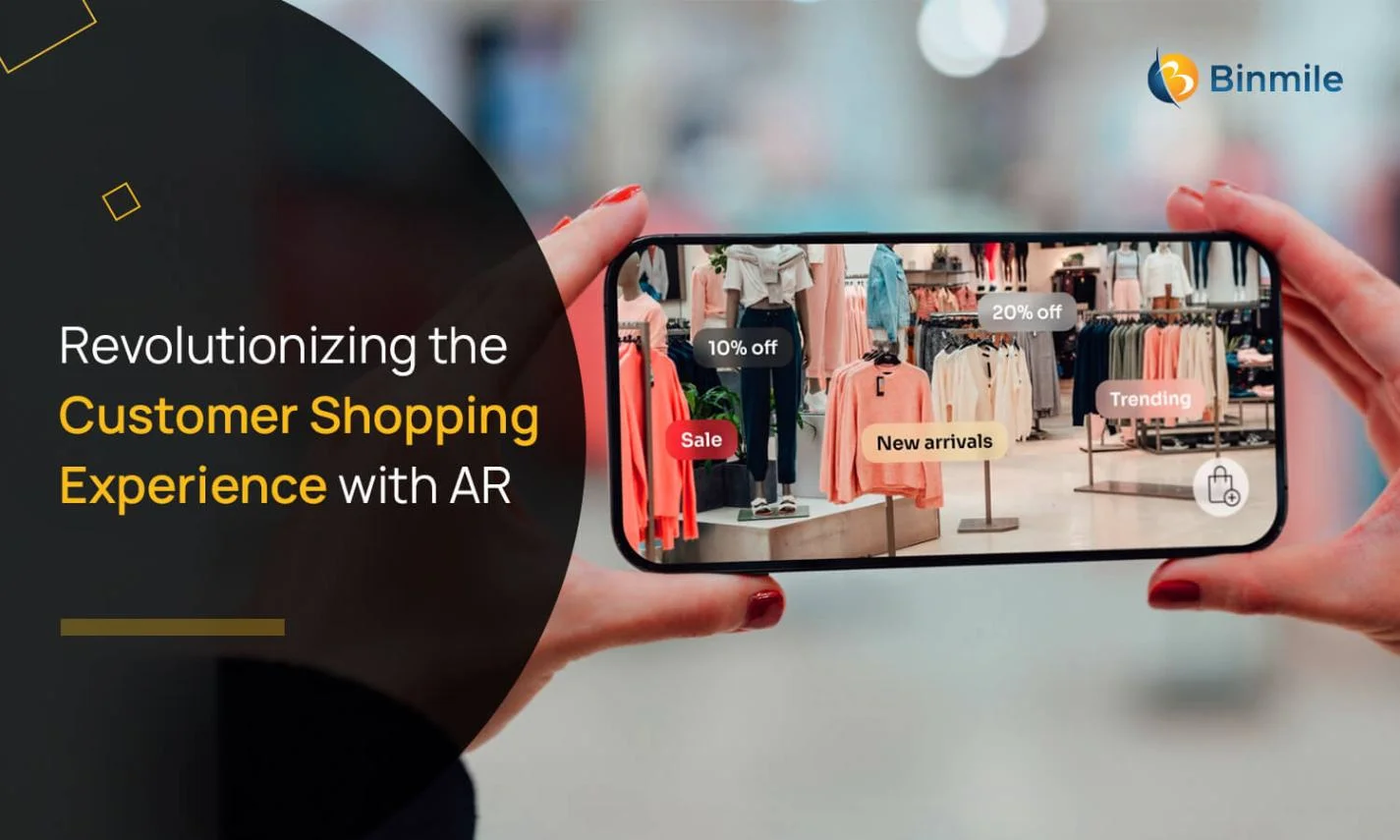The retail industry is undergoing a significant transformation thanks to e-commerce and omnichannel shopping. From warehousing and logistics to marketing and customer service, the adoption of cutting-edge technology is evident everywhere. As the world of retail evolves, so does how customers interact with products. Customers today favor personalization and convenience over price and product.
Augmented Reality (AR) is one technology changing the retail shopping experience. It replaces physical trials with virtual try-on solutions to help customers find items according to their preferences. Augmented intelligence helps create innovative retail experiences, influencing customers’ purchase decisions. According to research, 40% of customers are likelier to buy a product with an optimal augmented reality experience.
Let us learn how augmented reality can transform the retail industry for better customer engagement and sales.
The Importance of an AR Retail Experience
Users can contextually explore every product at scale with AR-integrated e-commerce websites and applications. Customers are likelier to convert when retailers provide immersive product discovery experiences. Research indicates that nearly 75% of the global population is estimated to adopt frequent augmented reality technology by 2025 for shopping purposes.
AR provides a multitude of possibilities for customizing consumer products. The number of product images and videos is no longer a barrier to potential customers. With augmented intelligence, each online session can become a powerful sales channel.
The benefits of using augmented reality technology in retail include:
1. Increase in Conversion and Sales
Augmented Reality in retail stores can improve the overall conversion rate. A recent Shopify report indicates retail conversion rates for brands adopting augmented reality increasing by almost 250% in a year. Customers can try out augmented reality apps for retail before making a purchase using efficient augmented reality apps. The Houzz study found that customers who were 2.7 times likelier to spend time on the app were 11 times likelier to make purchases.
2. Reduction in Returns
Statista estimates online returns cost retailers $550 billion yearly in lost sales. AR can help customers see how a product will look on them or in a physical setting before they purchase it. This gives them a better idea of whether or not the product is right for them, and it helps reduce the number of returned products.
In addition, AR can also be used to provide instructions on how to use a product, which can help reduce the number of returned products. AR can significantly reduce the number of return requests retailers receive, which can positively impact the bottom line.
3. Higher Customer Engagement
AR allows retailers to superimpose digital content onto the real world, creating an immersive and interactive experience for shoppers. For example, Sephora has developed an AR app that lets users try on makeup virtually before making a purchase. This allows customers to test out products before committing to them and creates a fun and engaging shopping experience that customers are sure to remember. By leveraging augmented reality in retail stores, brands can create unique and engaging shopping experiences that will help them stand out from the competition and increase customer loyalty.
4. Collecting Relevant Customer Data
Augmented Reality is increasingly used in retail to collect customer preferences data. By overlaying digital information on top of physical products, retailers can track which items are being viewed, how long they are being viewed, and what kind of interactions customers have with them. This data can be invaluable for understanding which products are most popular with customers, what promotions are most effective, and how to optimize the shopping experience.
Additionally, augmented reality can also be used to provide real-time feedback to customers about pricing and product availability. As technology continues to evolve, more retail applications will incorporate augmented reality into modern ways of doing business.
5. Contactless Shopping Experience
The COVID-19 pandemic has resulted in a fundamental shift in how consumers interact with businesses. In particular, there is a greater focus on contactless shopping experiences to minimize the risk of disease transmission. Augmented Reality in retail stores is well-suited to meet this need.
Augmented Reality apps for retail provide shoppers with an immersive, hands-free experience that allows them to browse and purchase products without physical contact with anyone or anything. This reduces the risk of disease transmission and provides a more convenient and efficient shopping experience. Businesses that deliver contactless shopping experiences are well-positioned to meet the changing needs of consumers.
6. Reduced Staffing Expenses
Augmented Reality is increasingly being used in retail settings to reduce staffing expenses. By using AR technology, retailers can provide an enhanced customer experience while reducing the need for human staff. For example, AR can provide customers with information about products and services, directions to specific items within a store, and even personalized recommendations.
By using AR, retailers can reduce the need for customer service staff and sales staff. In addition, AR can automate tasks such as stocktaking and inventory management to reduce staff costs and improve efficiency and accuracy. As AR technology continues to develop, more retail uses will likely be found for it, further reducing the need for human employees.
7. Improved Customer Loyalty
Augmented Reality provides an immersive experience that can’t be replicated online. For example, a customer looking for a new dress might be able to try on different styles and colors without ever leaving the dressing room. Or a customer trying to find furniture might be able to see how a piece would look in their home before making a purchase. This level of engagement can help to build customer loyalty and bring people back to the store again and again.
In addition, retailers can use augmented reality apps to provide exclusive content and offer only available in-store. This can further entice customers to visit the store and make a purchase. Ultimately, augmented reality creates a unique selling point for brick-and-mortar retailers that can help build customer loyalty and drive sales.
Also Read: Digital Twin Technology in Retail
Augmented Reality Applications in the Retail Industry
There are two techniques for deploying augmented reality in retail: in-store and out-of-store.
Augmented Reality in retail stores lets a customer experience augmented reality while within or just outside a store via a portable device, wearables, like augmented reality glasses, or specialized augmented reality hardware such as smart fitting rooms, interactive mirrors, shop windows, etc. The out-of-store concept entails using augmented reality apps to access AR from a different physical location. Of course, combining in-store and out-of-store tactics, or using an “omnichannel” strategy, would be the ideal course of action.
The use cases of augmented intelligence in the retail industry include:
1. Virtual Tours and Space Visualization
Augmented Reality can be used to significant effect in retail, especially when it comes to virtual tours and space visualization. By utilizing cutting-edge technology in the retail industry, 3D models can provide customers with a life-like experience of the store without ever having to set foot inside.
Moreover, this innovative use of computer vision and data analytics can completely take store design to the next level. Retailers and interior designers can have an accurate representation of how their workspace will turn out even before putting any on-the-ground effort into making it happen.
2. Color Coding and Matching
Augmented Reality technology is a handy tool for color coding and matching. This technology allows users to apply color swatches to real objects, saving time, effort, and costs associated with manually color-matching items. AR also works to rectify any mistakes that might occur when color matching with the help of real-time data.
Additionally, AR makes it easier for consumers to visualize what a product looks like without actually having to touch or view it in person. It allows them to make an informed decision instantly to create a smoother shopping experience overall. As more retailers adopt AR solutions, its ability to improve customer satisfaction and save on costs makes it an attractive proposition for businesses worldwide.
3. Outfit Trials
Augmented Reality technology is revolutionizing how consumers trial retail products. By utilizing sophisticated image recognition technology, a shopper can now use their smartphone or tablet to virtually try on items like hats, eyewear, and clothes. This allows customers to get an accurate idea of how different styles and colors look on them without having to try them on in-store. This leads to increased accuracy and convenience for shoppers and helps retailers improve customer interactions while optimizing inventory costs and maximizing retail space.
4. In-store Displays
Augmented intelligence is revolutionizing the way customers experience in-store displays. By letting shoppers interact with products and streamline their research process, AR has become an invaluable tool for savvy retailers. AR can create personalized, context-aware experiences that heighten the customer’s engagement with a brand and increase conversions.
Not only does it improve the shopping experience for customers, but stores can also save money by reducing costs associated with manufacturing physical displays. As customers rely more on smartphones to engage with physical stores, augmented reality technology is becoming an increasingly important part of a retailer’s strategy.
5. AR Fitting Rooms
Augmented Reality has revolutionized shopping, particularly when it comes to clothing. AR fitting rooms are the perfect example of this technology’s potential – they provide customers with an accurate virtual representation of how an item of clothing may look on them without trying it on physically. This makes for a better customer experience and solves the problems associated with physical fitting rooms, such as lengthy wait times and product damage.
Keep Reading: Google Cloud Vision API and AR for eCommerce Product Discovery
Conclusion
Leveraging augmented reality in retail is a step towards making more precise and efficient online and offline shopping decisions. Research indicates that 61% of the total consumer base prefers the AR retail experience. There are endless possibilities for how AR can be used in retail environments. By incorporating AR into their marketing strategy, retailers can create unique and engaging shopping experiences to capture shoppers’ attention and boost sales. Retailers looking to increase customer engagement should consider incorporating AR into their marketing strategy.
Binmile is an all-in-one platform that provides automation process analysis and enhancement services. With cutting-edge technology, Binmile assures a better customer journey with AR through a broad spectrum of quality assurance services.
Get the best for your futuristic digital transformation today!
Frequently Asked Questions
Leading retailers leveraging augmented reality include:
- IKEA: Virtual furniture placement through the IKEA Place app.
- Sephora: Virtual makeup try-on with the Sephora Virtual Artist.
- Nike: AR-powered shoe fitting through the Nike Fit app.
- L’Oreal: AR beauty and hair color testing via mobile apps.
- Zara: AR-enabled in-store displays for interactive fashion previews.
Common challenges include:
- Cost: Developing AR experiences can be expensive.
- Technology Integration: Ensuring compatibility with existing systems.
- Customer Adoption: Educating consumers on how to use AR tools.
- Data Privacy: Managing customer data responsibly.
Augmented reality enhances both online and in-store shopping by:
- Providing Virtual Previews: Letting customers see products in their environment.
- Improving Decision-Making: Offering detailed, interactive product demonstrations.
- Creating Personalized Experiences: Customizing recommendations and visuals.
- Increasing Customer Confidence: Reducing uncertainty and enhancing satisfaction.
By adopting augmented reality in retail, businesses can stay competitive, deliver unique experiences, and drive customer loyalty in an evolving marketplace.









